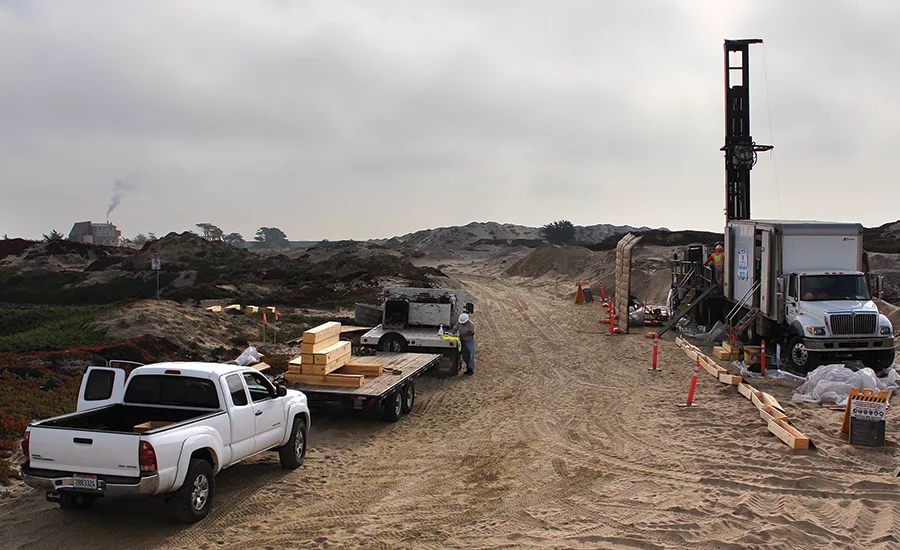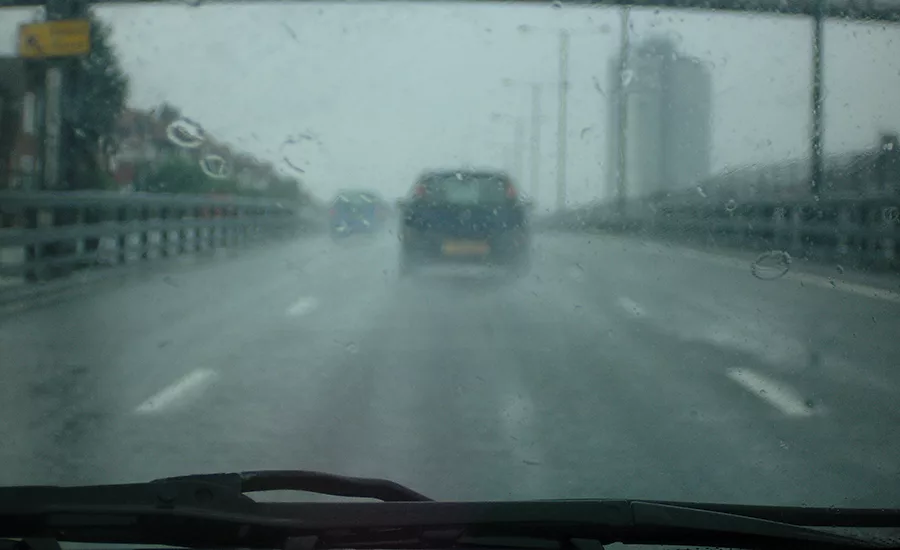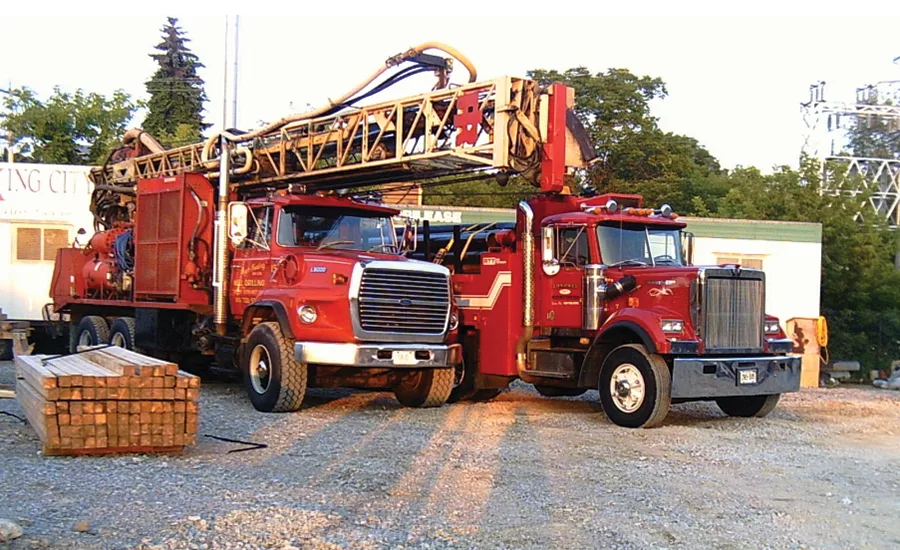Smart Fleet Management Helps Drilling Contractors Cut Risks

Truck-mounted drilling rigs, equipment trucks, pickups, trailers — it all needs to get to the jobsite. A good fleet safety policy can ensure it all gets there and back while minimizing liability. Source: California American Water

Adverse weather conditions make maintaining a safe stopping distance even more critical, particularly if you’re driving heavy equipment. Source: Morguefile.com

Small drilling companies should make sure drivers know and sign off on company policies before trusting them with their biggest asset. Source: Morguefile.com
In the following article, see how drilling contractors are taking steps to increase safety by decreasing driving dangers.
The work of drillers is dangerous in its own right. Operating heavy machinery, working around deep holes in the ground and working in all kinds of weather are wrought with potential safety issues. But another potential danger with drillers is the very act of getting to a jobsite. Driving large, cumbersome trucks early in the morning and then again later in the day when everyone is tired can be a very dangerous proposition. And that is why drillers are well advised to be proactive with driver safety.
Experts advise appointing one individual as the “fleet manager” to monitor driver safety. Even companies that only have a few vehicles should still have a manager responsible for this task.
“If you don’t have a designated individual overseeing driver safety, it won’t be sending the message to employees that it’s taken very seriously by management,” says Jon Cook, co-founder of JP Transportation Safety Consulting, a firm that works with companies to enhance driver safety and reduce risk.
First and foremost is to be comfortable with the individual behind the wheel. Conduct background tests on anyone taking the wheel, and be aware of any notable traffic violations or offenses within the prior five years. “It’s essential to do your due diligence up front,” Cook says, “to limit your risk from day one. Background checks are so simple and inexpensive nowadays that failing to do them is really irresponsible. If you don’t do them and hire a driver that shouldn’t be behind the wheel, you can potentially open up the door to legal liability.”
GPS tracking devices make it easy for fleet managers to monitor fleet driving habits and ensure safety in real time, even when they’re not in the office. With valuable insights into driver safety and tools such as driver safety report cards, route replay and instant alerts for unsafe behaviors, fleet managers gain assurance that their drivers and other motorists on the road are safe.
“Any business with a fleet should implement a GPS tracking solution to gain greater transparency into their fleet operations,” says Gary Hatfield, vice president at Mercury Associates, a fleet management consulting firm. “The most profound impact [of GPS tracking solutions] is the ability to reduce overhead costs — fuel, maintenance and insurance premiums — that can save a substantial amount of money,” Hatfield says.
Risky driving tendencies such as speeding, harsh braking and rapid acceleration often signal dangerous driving behaviors — including “lead foot syndrome” or tailgating. These risky behaviors are especially problematic in adverse weather conditions such as rain, poor lighting and snow, or when they are committed by drivers operating large, heavy vehicles. Large vehicles operate differently than small passenger cars. Drivers and fleet managers alike must take these differences into account before they hit the road.
Speeding is the most common risky driving behavior. Monitoring how fast vehicles travel using text and email alerts allows both drivers and fleet managers to identify unsafe drivers or other problematic driving patterns. In many cases, just knowing they are being tracked and receiving text message and email alerts themselves can have a significant positive impact on drivers’ safety. “It’s essential to be repetitive with it and always emphasize how the drivers are being tracked,” Cook says.
Harsh braking, one of the most common indicators of tailgating behavior, is another strong signal for future accidents. With a GPS tracking system, fleet managers can monitor drivers for these behaviors and other unsafe habits (such as rapid acceleration), and take steps to eliminate dangerous or hazardous driving habits.
Drivers’ dangerous habits improve when they know that their driving is being monitored, experts say. “There’s numerous benefits to monitoring driver activity,” Cook says. “Not only is it positive for the drivers, but by tracking them along with taking other safety measures, it’s possible to reduce insurance premiums as well.
GPS tracking devices collect information on how drivers behave in the field and transmit this data to a computer or mobile device, ready to be accessed at any time and from any location. In seconds, you can gain powerful insight into how your drivers behave in the field using a number of intuitive tools.
Using safety report cards and driver ratings, fleet managers can view daily safety scores or safety trends over time for individual drivers or their entire fleet. At a glance, fleet managers can see which unsafe driving behaviors drivers are committing, as well as when and where these dangerous behaviors occur. Many systems create stack rankings that allow a manager to determine the best- and worst-performing drivers. “With all this data in hand,” Cook says, “managers can review and analyze the performance of each individual driver, digest the data, and utilize it to improve or enhance driver safety.”
Knowing which drivers commit unsafe behaviors the most or least allows a manager to reward and reinforce safe driving habits, provide additional training on safe driving and coach drivers to safer driving habits.
Another valuable feature of GPS fleet management systems is interactive route replay. With this tool, fleet managers can view a visual history of a driver’s activity on a map along with indicators for unsafe activity or other key driving behaviors. Route replay allows fleet managers to view and play back each vehicle’s driving history using animated route replay and break each day down into detailed trip segments; they even can view street-level details for deeper insights.
By identifying trends in unsafe driving habits — such as which individuals frequently commit dangerous driving behaviors, what time of day these occur or whether they most frequently occur at specific locations — a fleet manager can determine practical ways to increase a fleet’s safety. For example, if most speeding alerts occur in a specific area where the speed limit changes, fleet managers can take the opportunity to advise their drivers to slow down in advance of the speed change.
Fleet managers also can configure their GPS tracking system to send real-time alerts to themselves and the driver in question whenever an unsafe driving behavior occurs. These alerts do more than inform drivers when they commit an unsafe action. In addition to training drivers to operate vehicles safely, alerts can help fleet managers identify trends and take steps to prevent unsafe behavior as it happens. “With all this data readily available,” Cook says, “it’s impossible for a driver to dispute it. What’s in black and white speaks for itself.”
It is very important for any driller with drivers on the road to also have a written manual that defines clearly the policies and procedures for drivers. The primary reasons behind this are to eliminate any confusion to drivers as to what the policies and procedures are, to promote safety, and to protect the organization. Employers never want to leave even the slightest doubt in a driver as to what policies are and what potential consequences are if those policies are not followed.
It’s also important for any drilling firm to underscore the overwhelming importance of safety and not taking unnecessary risks on the road. And lastly, policies and procedures are essential for organizations irrespective of their size to protect them from lawsuits. If a driver, for example, is terminated after not following a particular policy and then files a lawsuit against the company, the written policy can be a savior from financial culpability. One last point to note is to ensure every employee signs a copy of the policy book acknowledging that they have read it and fully understand it.
“An employee handbook or written manual is the go-to reference source for just about any situation a company may face,” says Cassandra Carver, a human resources consultant with New York City-based Astron Solutions. “If there’s a policy in place, a manager can point to it and clearly document a violation or breech. You really want to avoid employees coming back to a manager and saying ‘I didn’t know that we weren’t permitted to do that.’”
Fleet Safety Facts
$16,500
The average cost of a crash to an employer.
$74,000
The average cost to an employer of an on-the-job crash with an injury.
25-30%
The percentage of crashes in which distracted driving is a factor.
3.7
The number of seconds it takes to drive the length of a football field at 55 mph.
1.5 million
The number of arrests each year in the U.S. for DWI.
Source: OSHA.gov
Looking for a reprint of this article?
From high-res PDFs to custom plaques, order your copy today!






